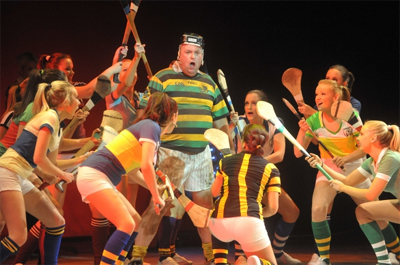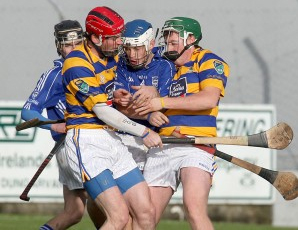Clash of the Ash: Higgs Boson Explained
10th Jan 2012
The Higgs Boson & Clash of the Ash
We have been receiving very encouraging rumours around the pubs of Cork harbour of late that the ‘God particle’ known as the Higgs Boson may be found in the Rebel County soon.
For those unaware of the scientific endeavour taking place on the Franco-Swiss border here’s a quick synopsis of what the hullaballo is about.
Imagine a very large space in the shape of a GAA stadium – this is like an atom.
Around the outside of the stadium are fast moving negatively charged electrons – these are the supporters without tickets who are looking to get a ticket as soon as possible. They would like to pair up with a positive charge – their ticket. It is their one and only desire in life.
.jpg) |
| Some tit looking for a hurley down the Pairc just before throw in |
Now picture the centre of the field with a load of fellas waiting around for the ref to throw in a sliothar. Every atom has a set number of protons and neutrons in centre field.
Also this is not your conventional GAA team formation. In fact the two teams in this particular stadium are not very spread out – much like a Sunday morning junior B game when the full back decides he’d have more craic in the middle of the field where all the action seems to be – even if the goalie is roaring like a crazed hyena that he has no cover for a goal hanger in the small rectangle.
Anyway, before anything happens the referee must throw in the ball. This is the beginning of time.
As we all know, the beginning always involves a clash of the ash. Scientists call this the ‘big bang’ and when this occurs our universe kicks off. Now hold this thought for a minute while we digress – and calm down there’ll be “at least one minute” of added time at the end to compensate.
In theory when you lash two hurleys of equal size and weigth off each other, the force of each one cancels the other out so neither hurley gets flung along the ground or flies into the air as long as each stick is wielded with equal force.
However, sometimes when your team nominates you for a clash ball your initial glowing pride at having been chosen by your comrades becomes clear when you discover your opponents have nominated their ‘mongo’ for the duel.
 |
| Clash of the gash. |
This is a person of considerable girth and strength who is selected purely to roughen up your team and tire them out (or let’s be honest injure them subtly so they have to bring on the trail of subs who were all ‘out last night’).
When he batters his stick against yours there’s a fair chance it’ll crack yours and the sliothar will go flying up the field towards your half backs. Feck!
The point is this. When two hurleys clatter off each other the forces are never exactly the same – even if the hurlers are almost exactly the same themselves and they are using the same shape and size ash – like twins Ben and Jerry O’Connor using one of their own homemade hurleys.
As Corkonians, we know that there are tons of things that influence the impact a hurley has on an object: grip, swing, twist, County Board whims etc so no strike is identical.
OK. Time on again and easy on the shouldering now lads!!
What this crowd over in CERN are trying to find out is what happens in that split second between all teams being equal and the moment when the clash occurs after the ref throws in the ball: what causes hurlers to not cancel each other out at every collision? And to bring it to its ultimate conclusion why are draws far less common than outright victories?
So this big giant 27km circumference underground tunnel they have on the border of Switzerland and Sarkozyville is basically a simulated game of hurling in which two particles (one from each team: positive and negative) perform a clash of the ash.
 |
| The Higgs Boson gives urine involuntarily secreted during a double shoulder its weight |
In theory, as opposites, they should cancel each other as they are lobbed at each other with equal force by the magic machine but something mysterious happens during the collision that results in what scientists call ‘matter’ or what we in Cork call ‘a ting’.
This thing, like a sliothar, has a weight (we would say ‘mass’ but that would complicate things as many people at a hurling match would have been to mass already that day) but nobody knows how it got its weight. It is this mysterious ‘yoke’ that gives the sliothar its weight that the scientists are trying to find.
They calls it the ‘Higgs-Bosun’ boy.










